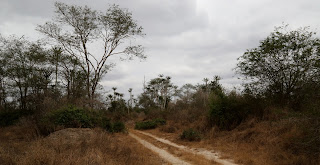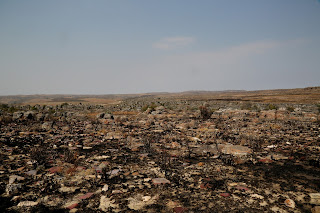Arrived in Luanda on 9th
September after an unremarkable flight from South Africa. I was a little
nervous on landing because I only have a yellow fever exemption letter not the
certificate because of my age (I am over 60). However after a little persuasion
I got in the country! No one from the hotel there to pick me up, so managed to
get a lift with some merchant seamen on the way to the docks where their ship
was at anchorage. All nice guys & thanks for the help.
They dropped me at my hotel & what a
dump! $180 a night, for what? Internet only worked at snail pace in the lobby
but arranged to meet up with the ground agent for the tour early on the 10th.
Really looking forward to this tour – there some rare & exceptional birds
on offer!
Paul picked me up in the dark & took me
back to the airport to meet the rest of the group. We left at 06.15 hours &
drove to Mussulo Bay, where we saw a variety of waders & water birds. But
more importantly we also saw Bubbling Cisticola & Rufous-tailed Palm Thrush.
A little further on we saw 40+ Golden backed Bishops: a brilliant endemic to get
so early in the trip.
We then made a quick stop at the Kwanzi
River Mouth & nearby golf course where the main species for me was Mangrove
Sunbird, which we saw exceptionally well.
Once we crossed the river we entered
Kissama National Park & the landscape was dominated by Baobabs & many
species off Euphorbia trees. This habitat was quite new to me & we made a
couple of birding stops without seeing anything exceptional.
We arrived at Muxima around 2pm & then
set out once more to an extensive area of mixed forest on a floodplain. We
bumped into a record nine Grey-striped Francolin, eight endemic Red-backed
Mousebirds; a pair of White-fronted Wattle-eyes, which performed beautifully for
all; five Gabela Helmetshrike; a wonderfully co-operative Monteiro’s Bushshrike
& two Hartert’s Camaroptera. What an outstanding first day!
Dawn of the 11th September was
dark & gloomy, threatening rain. So it proved later in the morning
with a heavy downpour in the middle of our birding! Birding was very slow, but
a Forest Robin showed well after a little coaxing! I finally got good views of
Pale Olive Greenbul after un-tickable views yesterday & the finale was
finding a female Petit’s Cuckooshrike (a species I had missed in Gabon).
The afternoon was even slower than the
morning in the gloomy conditions & we didn’t start picking up new species
for the trip until we left the forest & birded some cleared areas around
some local farmer’s houses. Here we saw 40+ Mottled Spinetails; a Boem’s
Spinetail & a Grey Kestrel. But the highlight for many was at least 12
Black-faced Canaries sitting up nicely for good scope views.
We then encountered the local governor of
the town & MPLA representative (remember the Angolan Civil War)?
After this we drove to the town for some
sightseeing over the river & town. The old slave quarters had recently been
restored (well kind of)! And with that we headed to our hotel to yet another
night without hot water!
Left the hotel early on 12th
September, we drove to Sumbe but first made a short stop in woodland for a bit
of birding where we saw 3 Carp’s Tit, a regional endemic. Other birds included:
Palm Nut Vulture; 150+ Mottled Swift; Green Wood Hoopoe; Black Scimitarbill; Angolan Batis; Orange-breasted Bushshrike; 7 Southern White-crowned Shrike; Green Crombec; Hartert's Camaroptera; Grey -Tit Flycatcher; 5 Rufous-tailed Palm Thrush & 35+ Golden-backed Bishop.
After lunch we drove to
Lobito, which had some nice wetlands with lots of Lesser Flamingos & a
variety of other water birds. We arrived at the attractive town of Benguela in
the early evening with Bradfield’s Swifts circling overhead. The hotel was the
best yet. I had hot water!
Palm Nut Vulture; 150+ Mottled Swift; Green Wood Hoopoe; Black Scimitarbill; Angolan Batis; Orange-breasted Bushshrike; 7 Southern White-crowned Shrike; Green Crombec; Hartert's Camaroptera; Grey -Tit Flycatcher; 5 Rufous-tailed Palm Thrush & 35+ Golden-backed Bishop.
These wetlands provided some good birding.
Left in the dark, for an unnamed site around
60kms inland, which was an area of broken hills with sparse woodland &
scrub. We got great views of Hartlaub’s Francolin, & a few other birds like
White-tailed Shrike; Kalahari Robin & Cape Penduline Tit.
The rest of the afternoon was spent driving
to Lubango & the last two hours were spent at Tundalava Gorge.
The 14th September dawned dull
& very windy but it turned out to be a superb day! We left at dawn for the
Tandavala Gorge & spent a couple of hours getting Swierestra’a Francolin to
show itself.
We then walked the shrub grasslands & a nearby miombo woodland
area before going back to town for lunch & then doing the whole thing again
in the afternoon! Highlights included:
Augur Buzzard; 3 Temminck's Courser; 2 Freckled Nightjar seen; 25+ Bradfield's Swift; Lanner Falcon; White-tailed Blue Flycatcher; Spike-heeled Lark; 2 Rockrunner; 6 Wailing Cisticola; Wing-snapping Cisticola; Black-chested Prinia; Grey Apalis; 2 Angolan Slaty Flycatcher; 4 Angolan Cave Chat; Bocage's Akalat; 5 Short-toed Rock Thrush; 2 Miombo Rock Thrush; Bronzy Sunbird; Ludwig's Double-collared Sunbird; Oustalet's Sunbird; 10 Angolan Waxbill; 2 Buffy & a Striped Pipit.
Augur Buzzard; 3 Temminck's Courser; 2 Freckled Nightjar seen; 25+ Bradfield's Swift; Lanner Falcon; White-tailed Blue Flycatcher; Spike-heeled Lark; 2 Rockrunner; 6 Wailing Cisticola; Wing-snapping Cisticola; Black-chested Prinia; Grey Apalis; 2 Angolan Slaty Flycatcher; 4 Angolan Cave Chat; Bocage's Akalat; 5 Short-toed Rock Thrush; 2 Miombo Rock Thrush; Bronzy Sunbird; Ludwig's Double-collared Sunbird; Oustalet's Sunbird; 10 Angolan Waxbill; 2 Buffy & a Striped Pipit.
The 15th was a drive over the
Leba Pass to the woodland & scrub/farmland at the base of the mountains. We
birded here from 7 am -9.30 am.
Highlights included:
Red-necked Spurfowl; 30+ Bradfield's Swift; Common Scimitarbill; Bennett's Woodpecker; 2 Hartlaub's & 5 Bare-cheeked Babblers; 4 Meves's Starling & 2 Great Sparrow.
Highlights included:
Red-necked Spurfowl; 30+ Bradfield's Swift; Common Scimitarbill; Bennett's Woodpecker; 2 Hartlaub's & 5 Bare-cheeked Babblers; 4 Meves's Starling & 2 Great Sparrow.
Then we drove to the desert plains where we
saw the Benguella Long-billed Lark and both Ludvig’s Bustard & 3 Ruppell’s
Korhaans.
On the return journey we stopped at an area
of desert koppies where we saw the local race of Grey-backed Cisticola.
We ended the day looking once again for Cinderella Waxbill at the same
area as in the morning. This time we scored with four!














































No comments:
Post a Comment